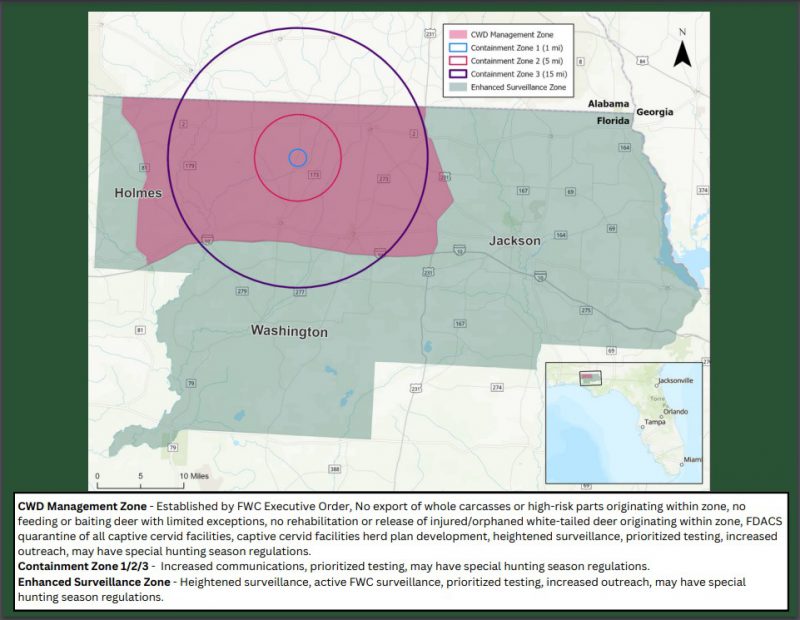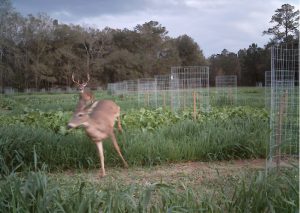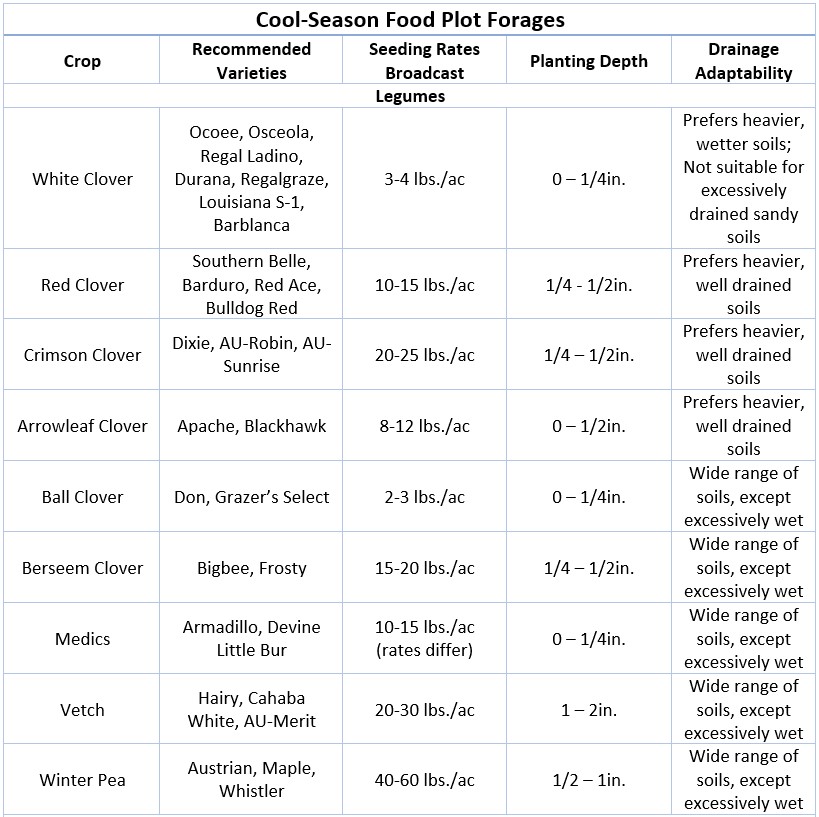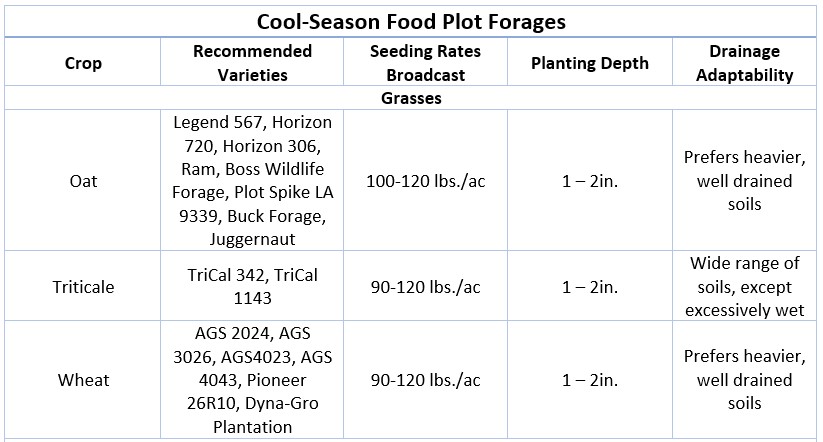With the recent discovery of CWD in Florida and the subsequent prohibition of feeding deer within the CWD Management Zone, there has been some additional motivation applied to hunters/land managers to establish new food plots. Moreover, the timing and unexpected nature of the discovery have hunter/land managers somewhat in “scramble mode” to make the shift away from feeders to plantings before archery season starts (10/21 in the Panhandle). Whether or not you are in the CWD Management Zone, if you have been contemplating establishing food plots for a long time the following comments are worth considering as you work through the process of establishing a new food plot.

CWD Management Zone Map. Feeding and/or baiting deer is no longer allowed within the management zone (red area on map). Courtesy myfwc.com
First, food plots are not corn feeders. That is to say that food plots should be viewed as habitat improvements, not attractants (even though they may well improve the likelihood of seeing deer and other game species at a specific location) and their success should be evaluated accordingly. Food plots have the most positive impact when they are maintained year-round with cool and warm season plantings. They are long-term investments.
When it comes to food plots, size really does matter. Food plots need to be no less than ½ acre in size, preferably between 1 to 5 acres. Maximum habitat benefit being reached when food plots make up approximately five percent of the managed acreage. The kinds of plants in food plots are, by design, ones that wildlife find highly desirable (because they are highly nutritious). Considering this, it is easy to understand why plantings smaller than ½ acre struggle to establish – the plants simply don’t get a chance grow past the seedling stage.
After a location is identified, it is crucial to manage unwanted vegetation prior to preparing the soil and planting the food plot. If it is not eliminated, existing vegetation will compete tremendously with food plot plantings. Even if mechanical disturbance (disking, tilling, etc.) appears to remove the existing vegetation, much of it will regrow. This regrowth from established root systems will be more than a match for new seedlings. Apply herbicide before you begin soil preparation. Equally as important, give herbicides sufficient time to work before mechanically disturbing the site (weeks, not days). Specific herbicide recommendations will vary depending on what vegetation you are trying to manage, but most food plot site prep applications will involve fairly high rates of glyphosate. Don’t hesitate to call me (850-638-6180) – we can discuss your site and dial in a herbicide recommendation. You do not want to skip this step; get in front of weed pressure before you plant.
If you want a food plot to be productive and successful, you must effectively address soil fertility. First and foremost, soil pH must be corrected. Any needed applications of lime/dolomite need to take place first, well before any other fertilizer is applied (ag lime can take months to go into soil solution and alter soil pH). If fertilizers are applied before the soil pH is corrected the nutrients may still be unavailable to the plants. Once a food plot site is determined, collect a representative soil sample from the rooting zone and submit it to a lab for analysis. This is the best way to get the information needed to make informed choices regarding lime and fertilizer applications. Talk with the folks at your local Extension Office for more info on how to collect and submit soil samples. Take and submit soil samples now. Apply any needed lime soon, during land preparation. Apply recommended fertilizer (N, P, K, and micros) at planting or soon after emergence. Fertilizer applied when there are no plant roots present to adsorb it may be lost from the root zone with heavy rainfall.
By far the most common food plot question I receive is “What should I plant?”. I intentionally held this until last, because if the topics above are not addressed properly, plantings will not be successful. I included the table below to help answer the “What should I plant?” question. To accompany the table, here are some additional statements to help guide your crop selection.

Note the exclusion cages in the plots of forages being evaluated at the University of Florida’s North Florida Research and Education Center. Photo Courtesy of Holly Ober
- Forage varieties matter. Use varieties that will work in Florida (see table for specifics). There are lots of forages sold locally that will not grow well locally. Sourcing seed can be challenging, start early, start now.
– - The concept of blending forages is great, and highly recommended. That said, be careful with pre-packaged mixtures. You’ll generally get more of the “good stuff” by putting together your own blend. When making your own blend, use ½ of the high end of the seeding rate for each forage you include. Don’t go crazy, 3-5 different forages is plenty.
– - Try to utilize forages that are well adapted to your site. The table shows varieties that are adapted to Florida and includes comments on site preference as it relates to drainage. You need to account for your site’s drainage characteristics when selecting forage varieties. Excessively well drained – deep sands; Moderately well drained – good soil by FL standards; Poorly drained – stays damp and/or will stand water seasonally.
– - If deer are the primary game species you are managing, focus on broadleaf plants (legumes and brassicas), not grasses. Hunters like grasses because they come up fast and are relatively easy to grow, deer like broadleaf plants because they are generally more digestible and higher in nutrients. Some grass in the blend is fine but don’t skimp on the broadleaves.
– - Some of the broad-leaved plants, particularly clovers, are highly preferred by deer but somewhat slow to establish. This combination can make it appear that the clovers don’t come up at all or preform very poorly. Before you jump to those conclusions, I would encourage you to use an exclusion cage or two in your plot. The cage will show you how the plant performs without grazing pressure. A few years of observation can really enable you to dial in what your deer prefer the most and adjust your plantings accordingly.
– - Don’t forget about planting date and depth. To keep life simple, let’s say that everything included on the table should be planted between October 1 and November 15 (ideally, triticale, wheat, and rye would be held until after October 15). Planting depth is very important and is a major factor in determining which forages can/should be planted together. It is perfectly acceptable to plant the deeper seeded grasses first and then come back over the field to plant the shallow seeded broadleaves. To achieve a target planting depth of ½” or less the soil will need to be packed prior to planting.
Food plots are not simple, but they can be very rewarding. There are way more factors to consider than what I included here. See the additional resources linked below and contact your local Extension Office or myself to discuss further.
–
Printable Cool Season Forage Table
More Resources:
Establishing and Maintaining Wildlife Food Sources
A Walk on the Wild Side: Cool-Season Forage Recommendations for Wildlife Plots in North Florida
- Peanut Maturity Update – 10/9/25 - October 10, 2025
- Fall Can be a Great Time for Vegetation Management - October 3, 2025
- Peanut Maturity Update – 9/25/25 Edition - September 26, 2025



